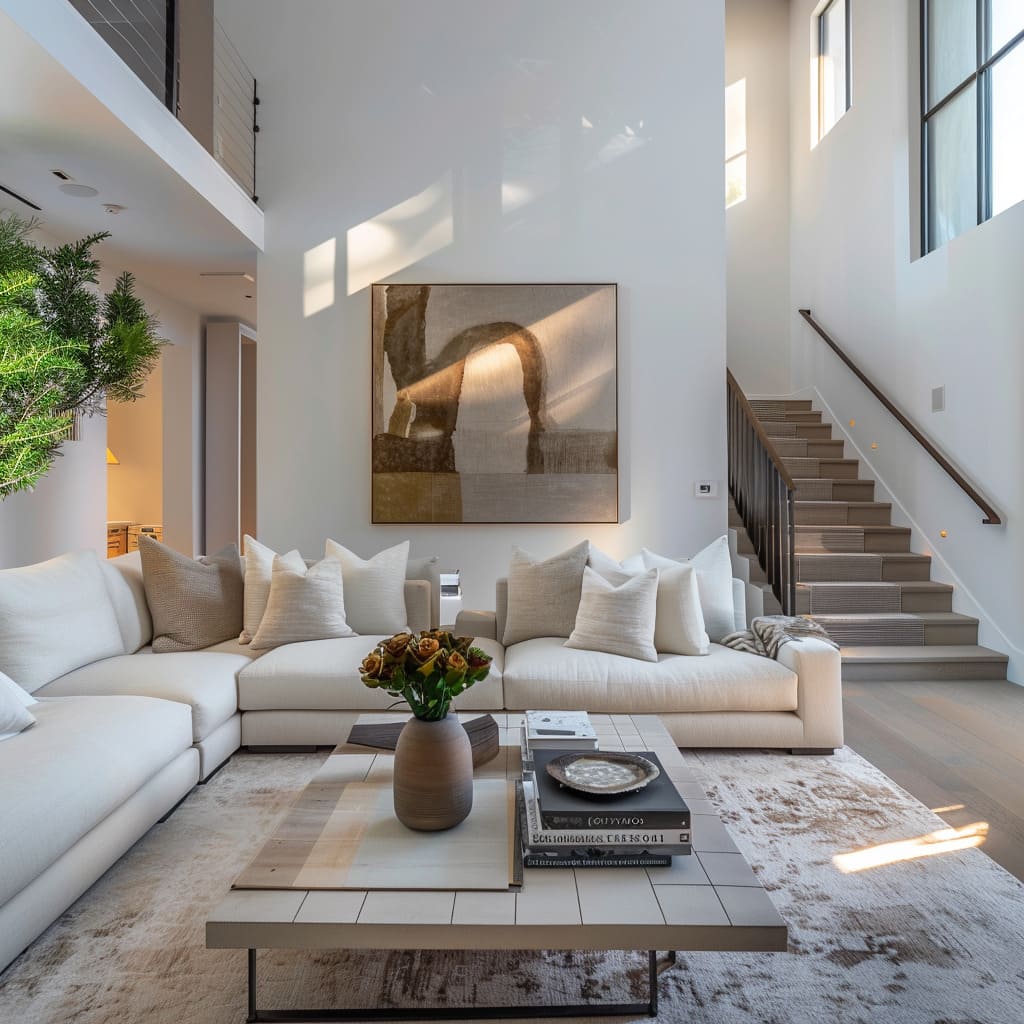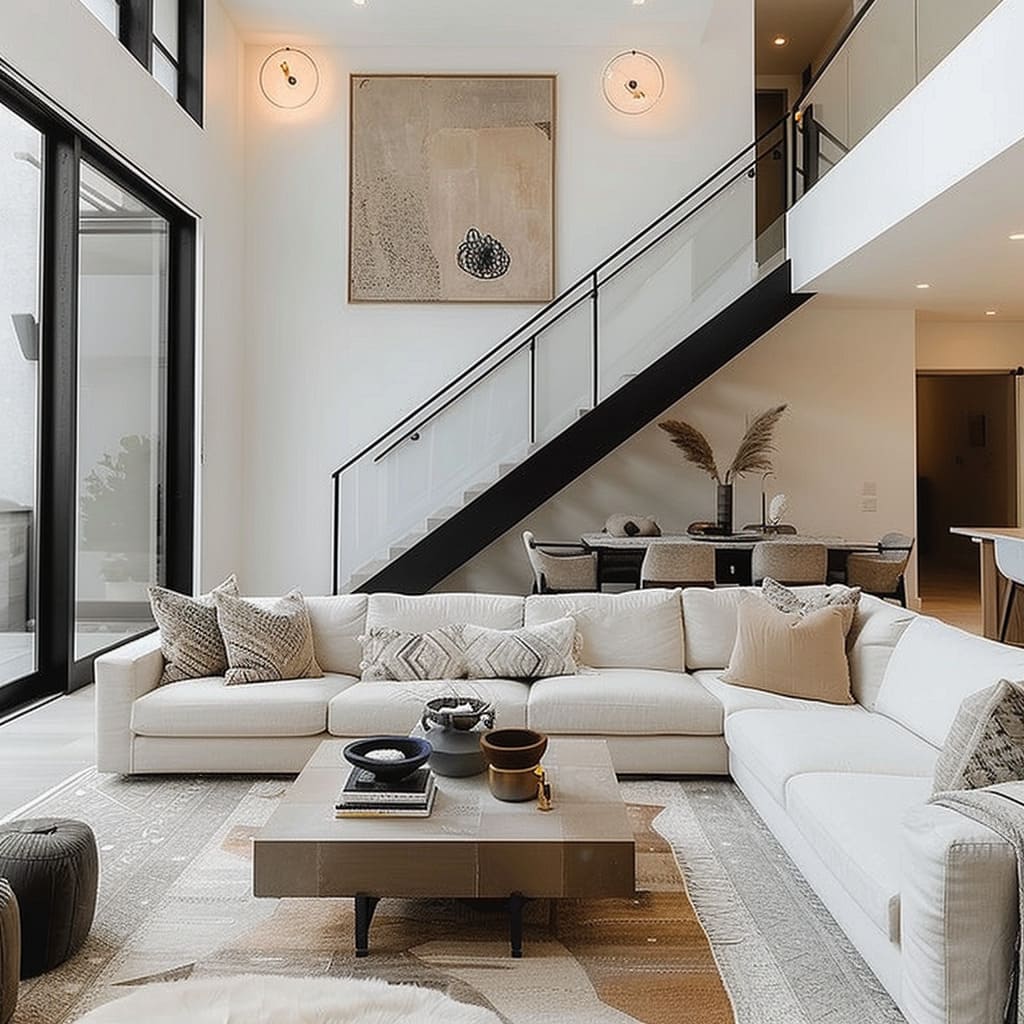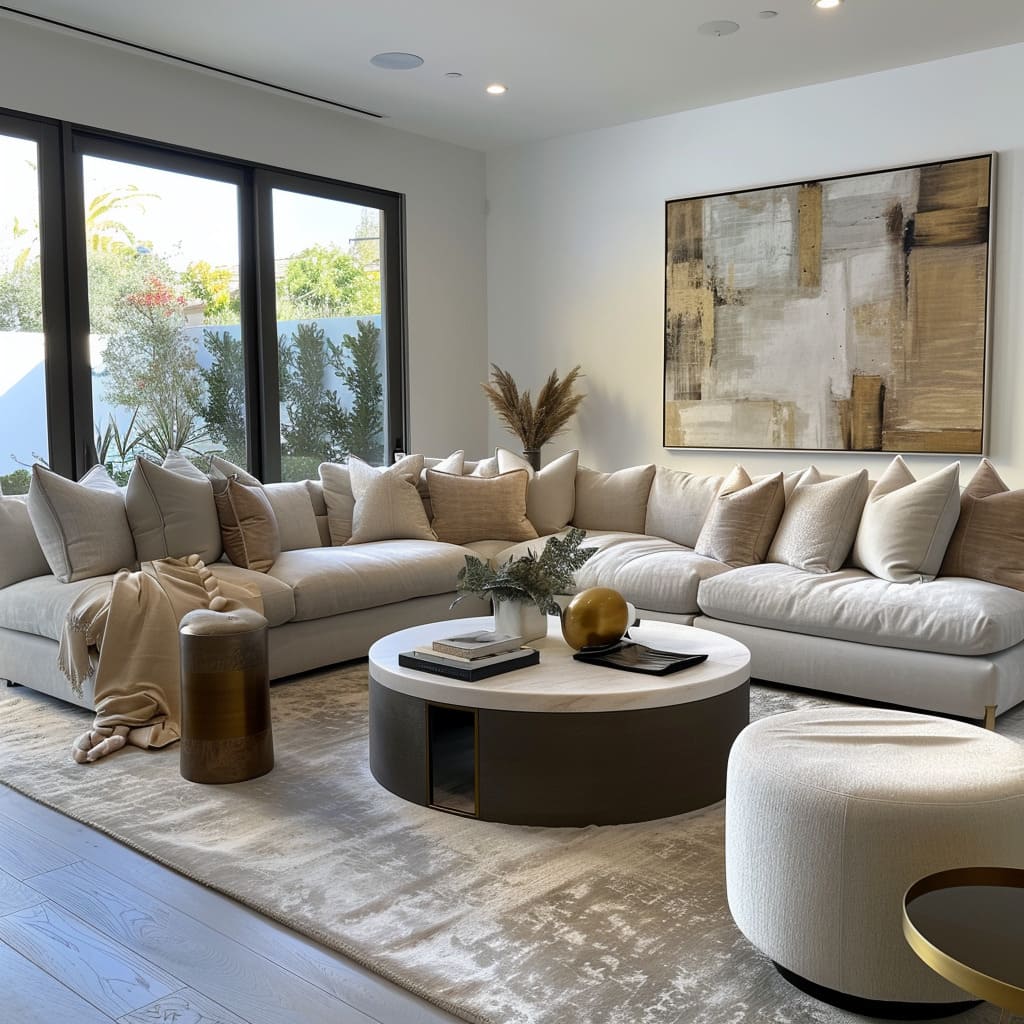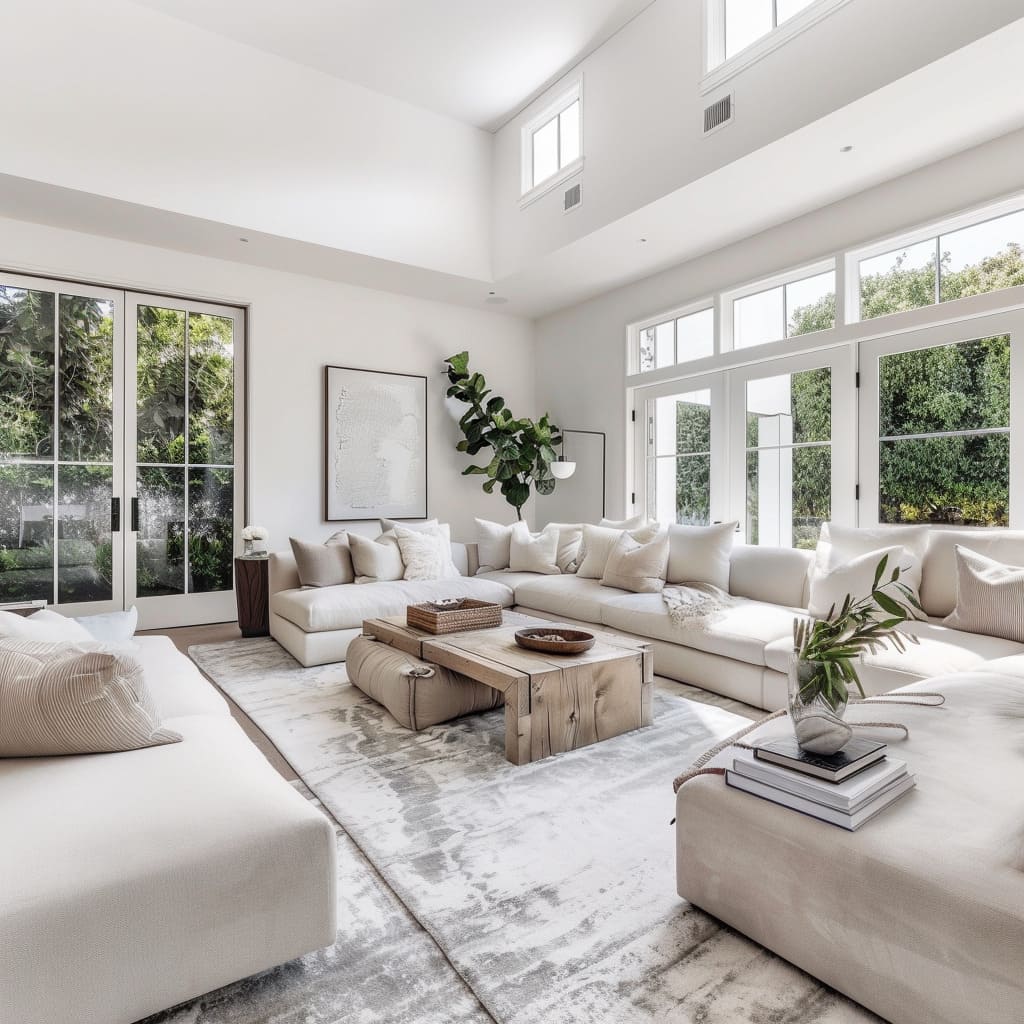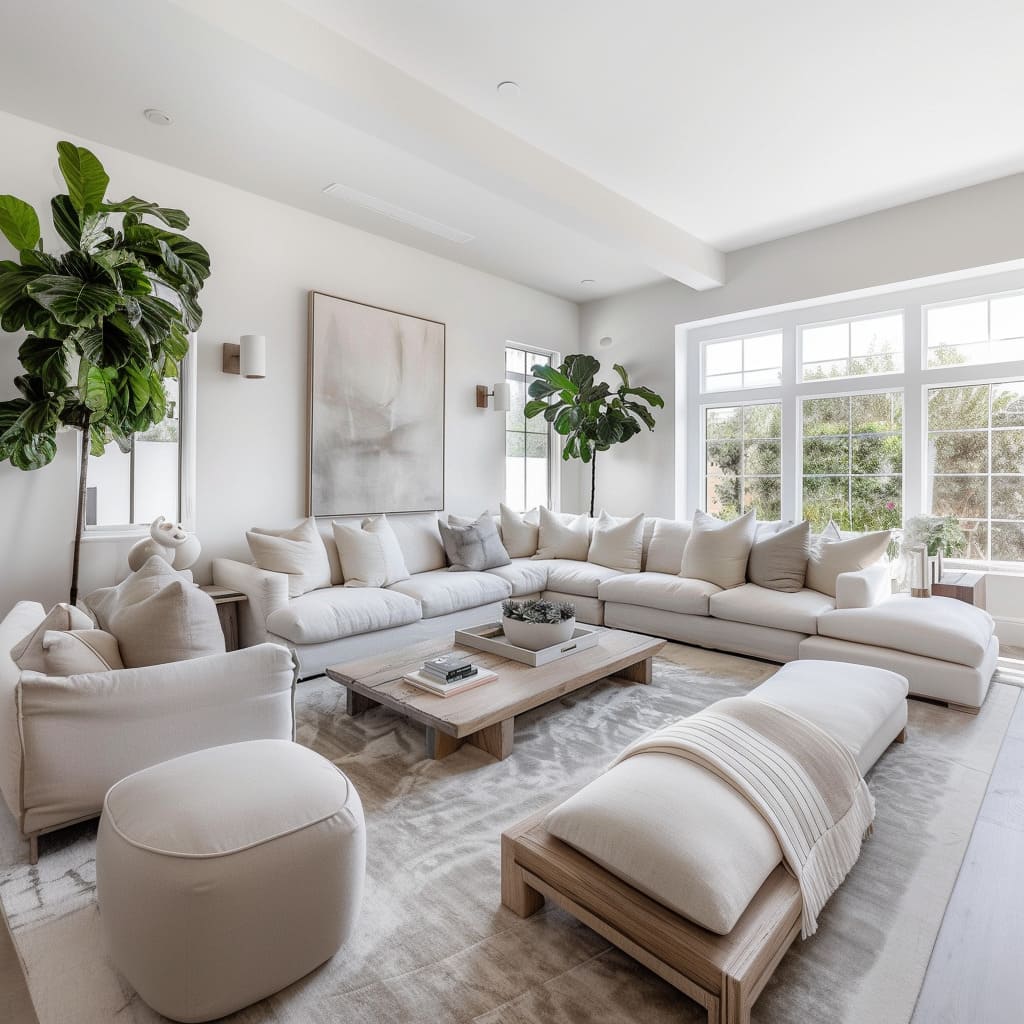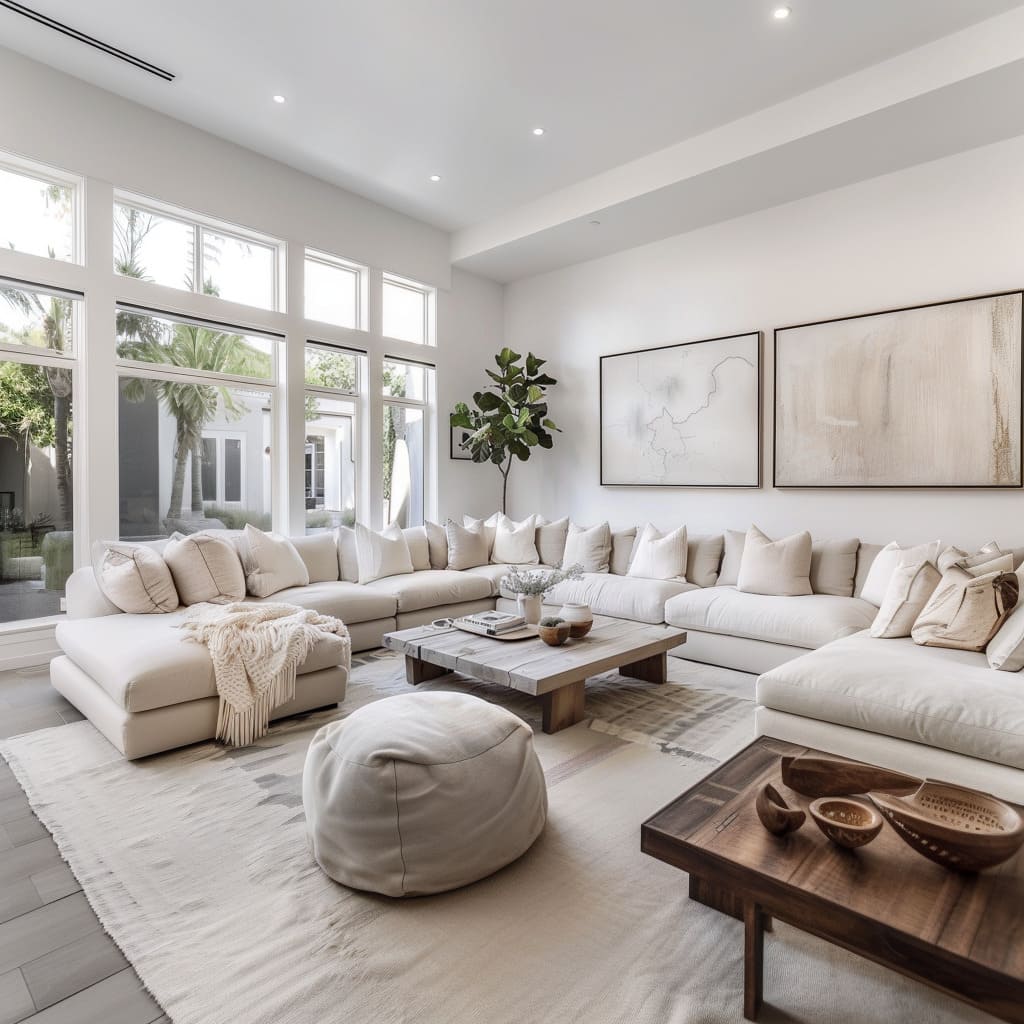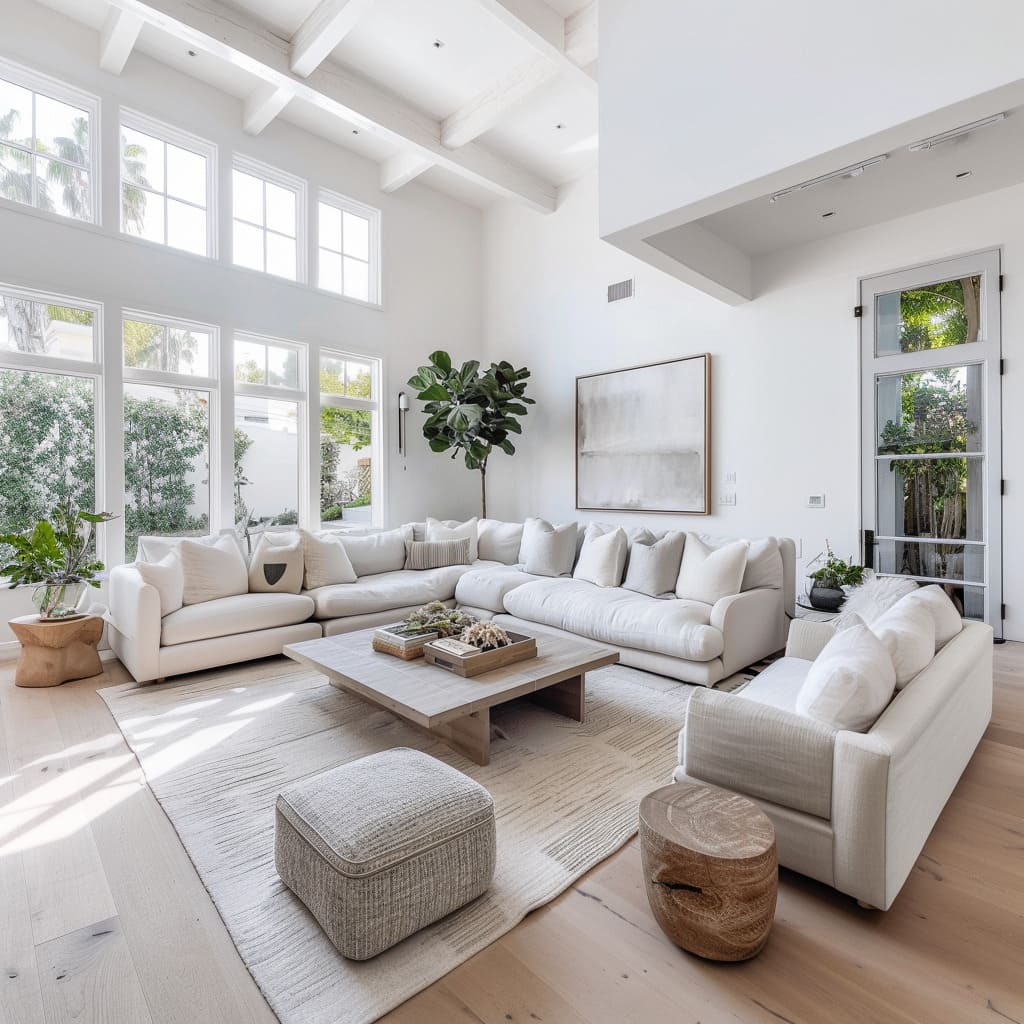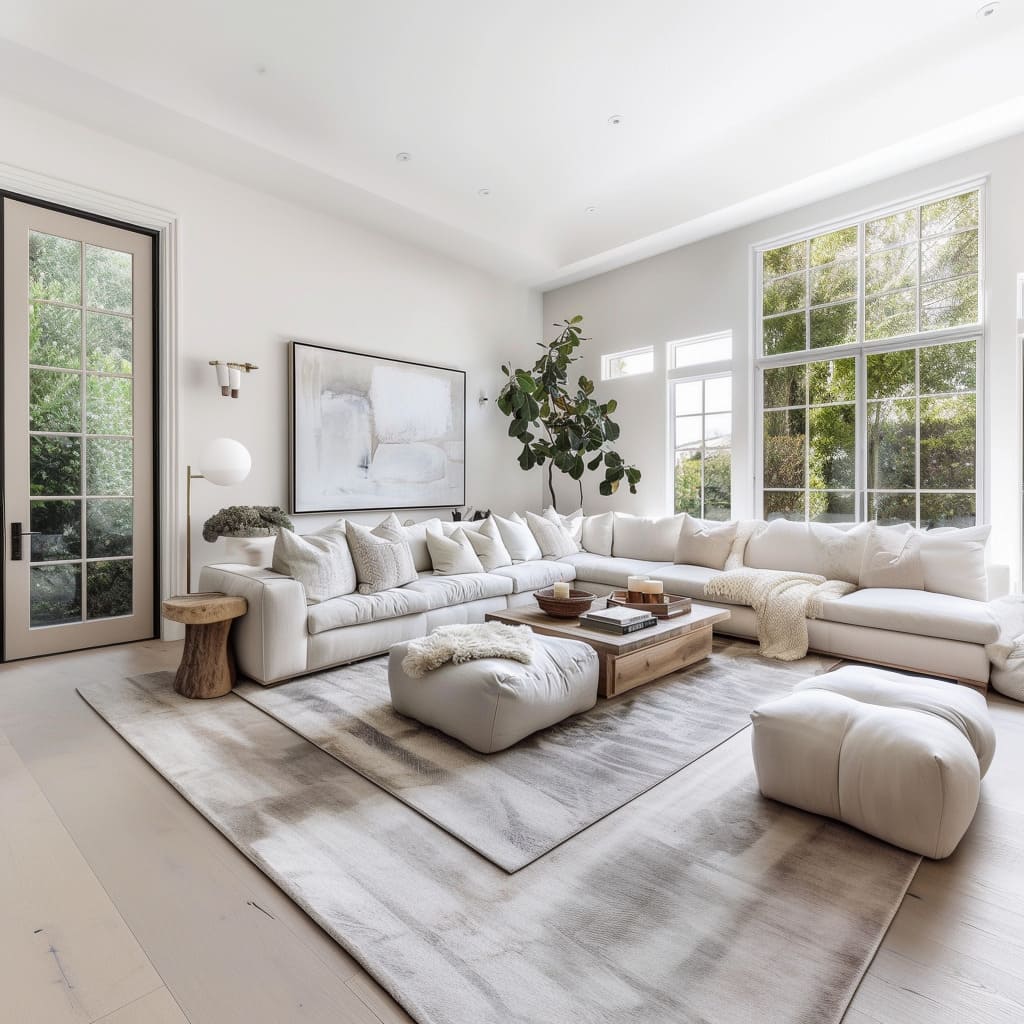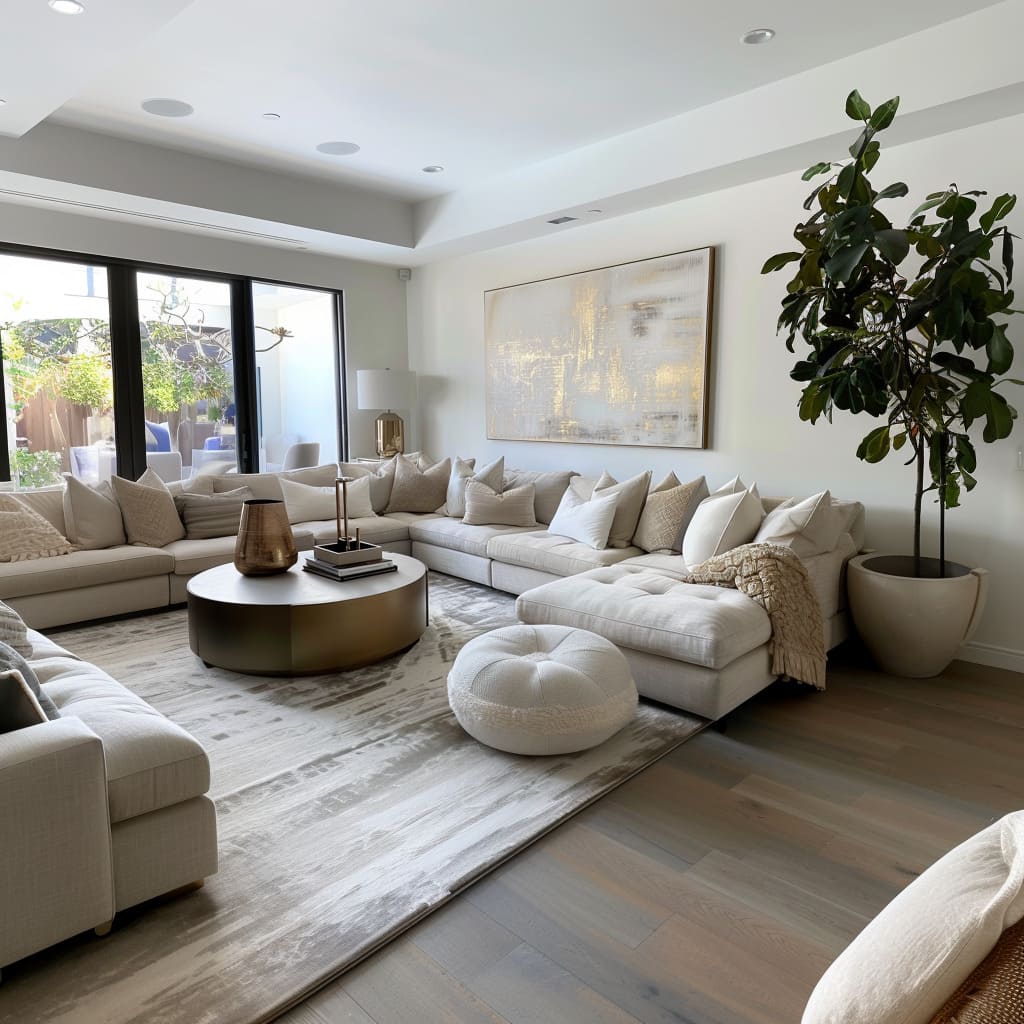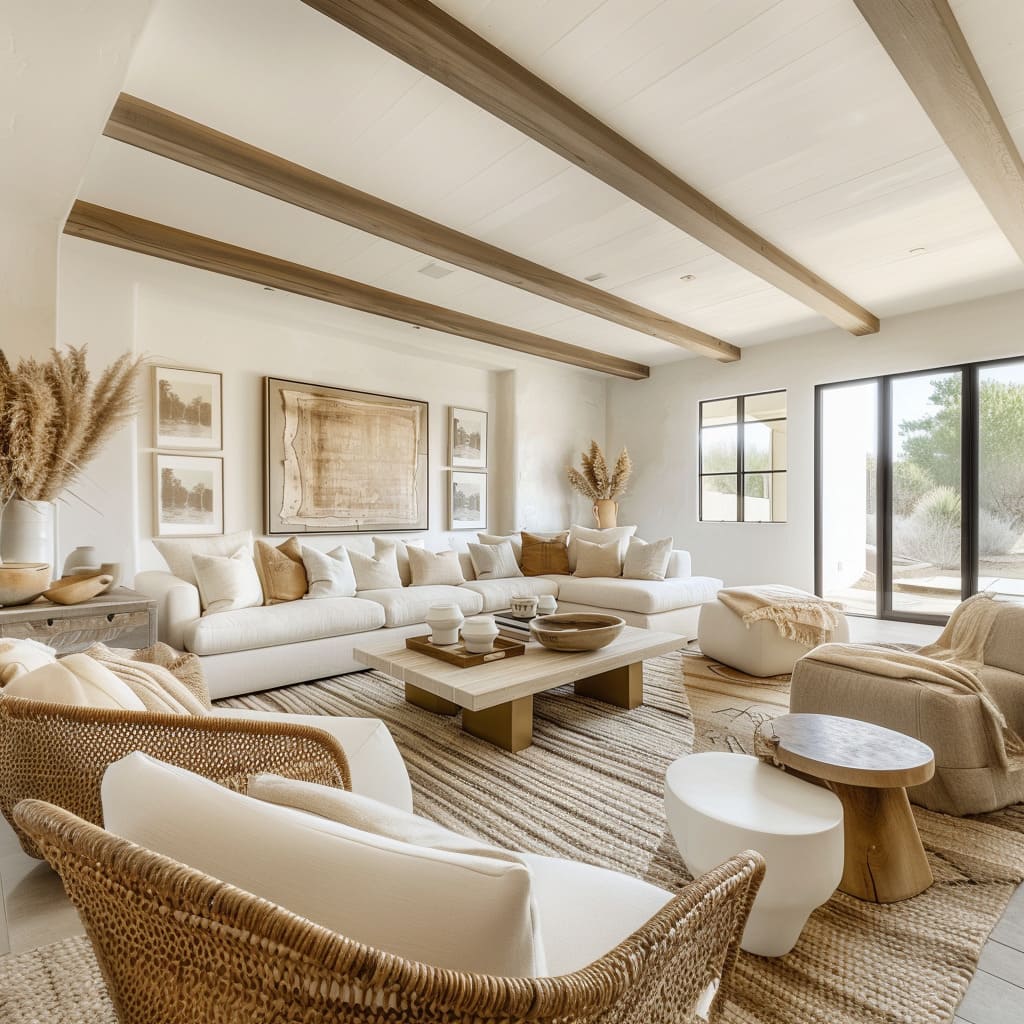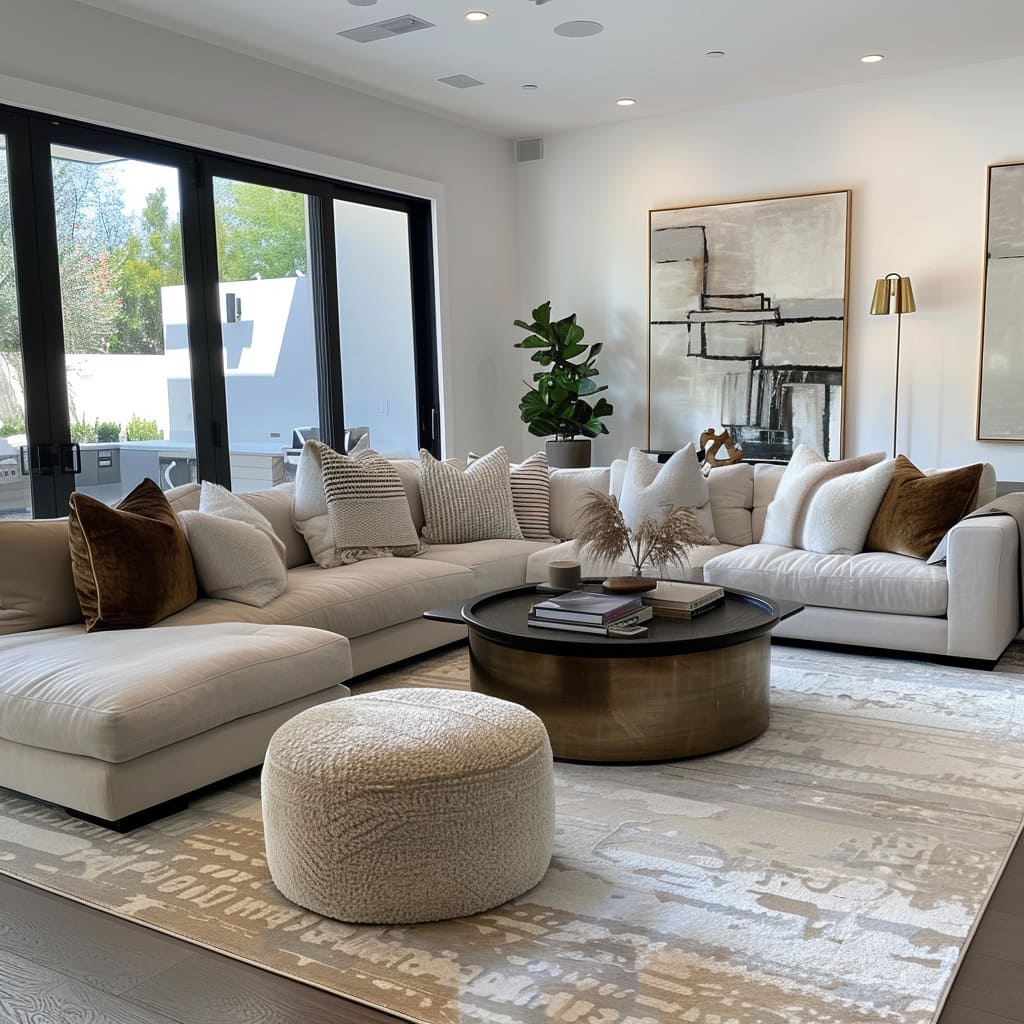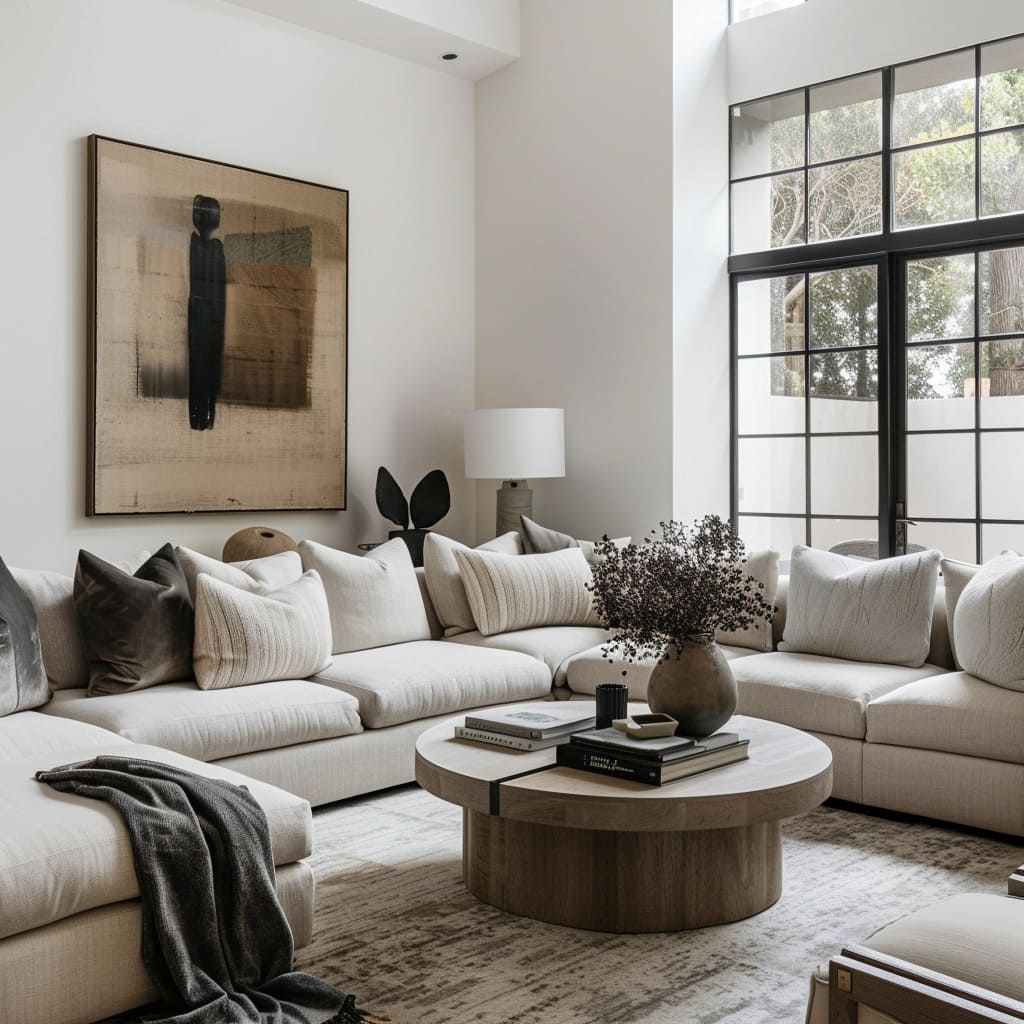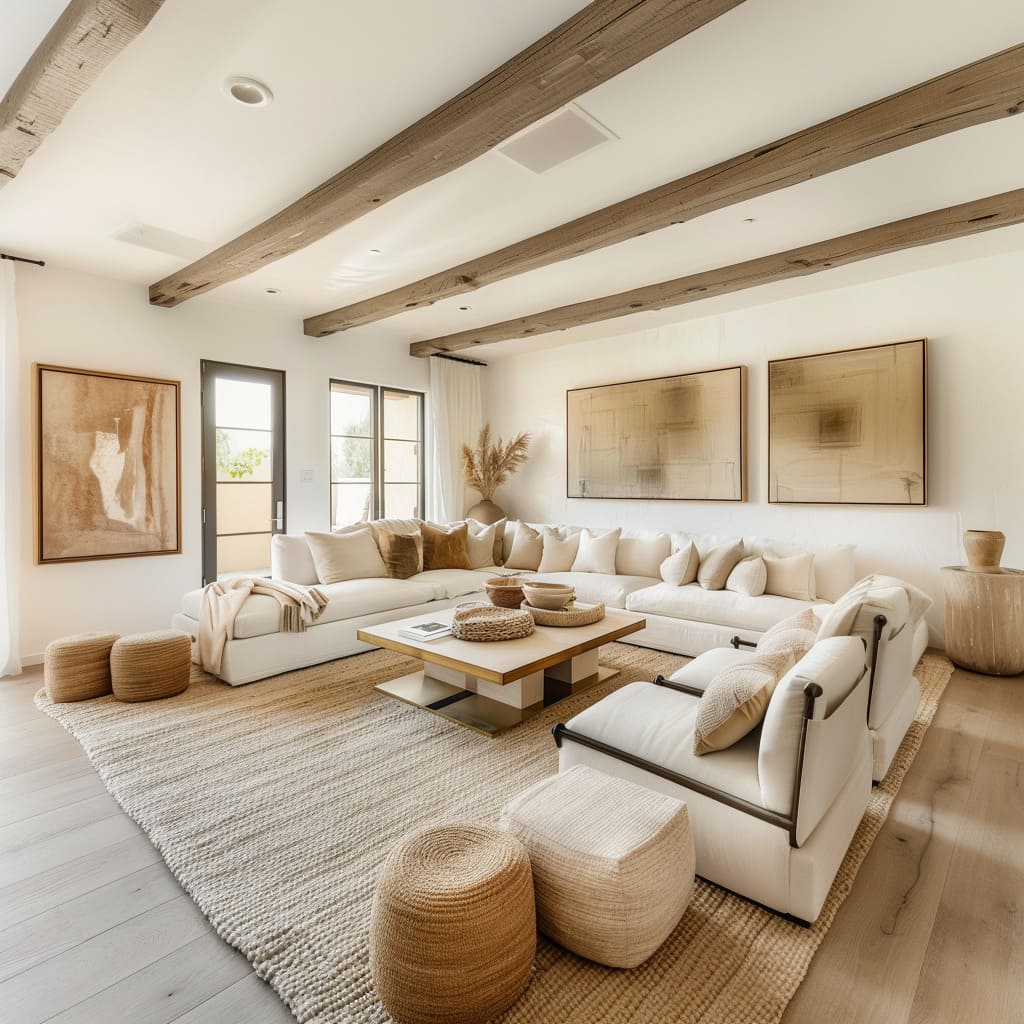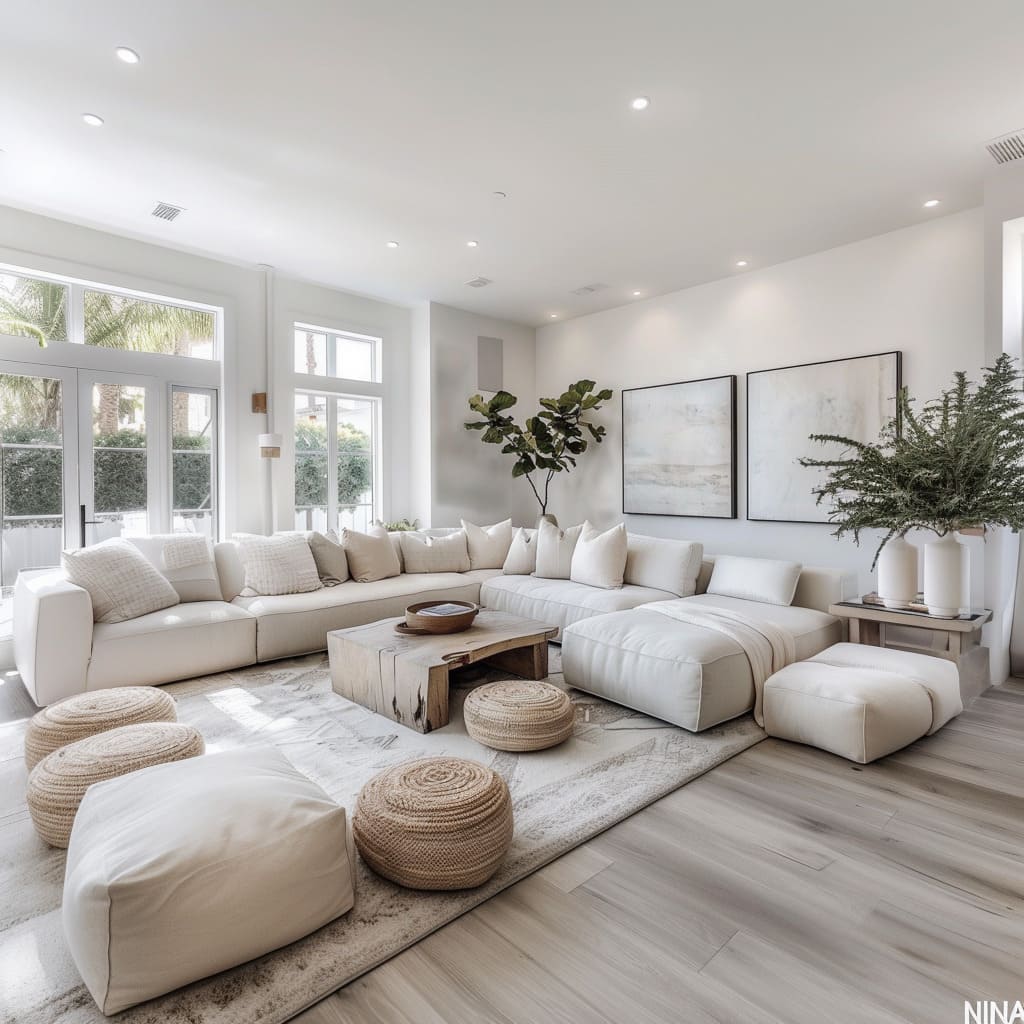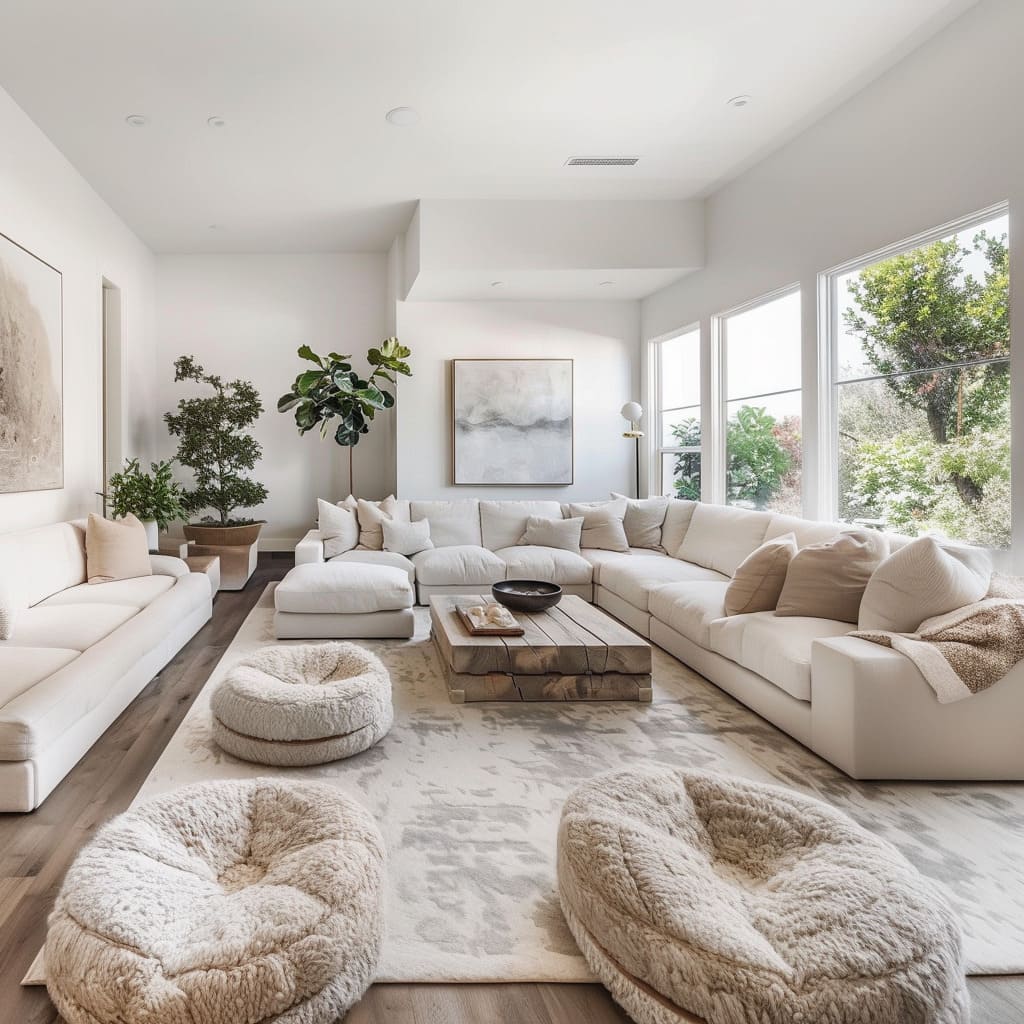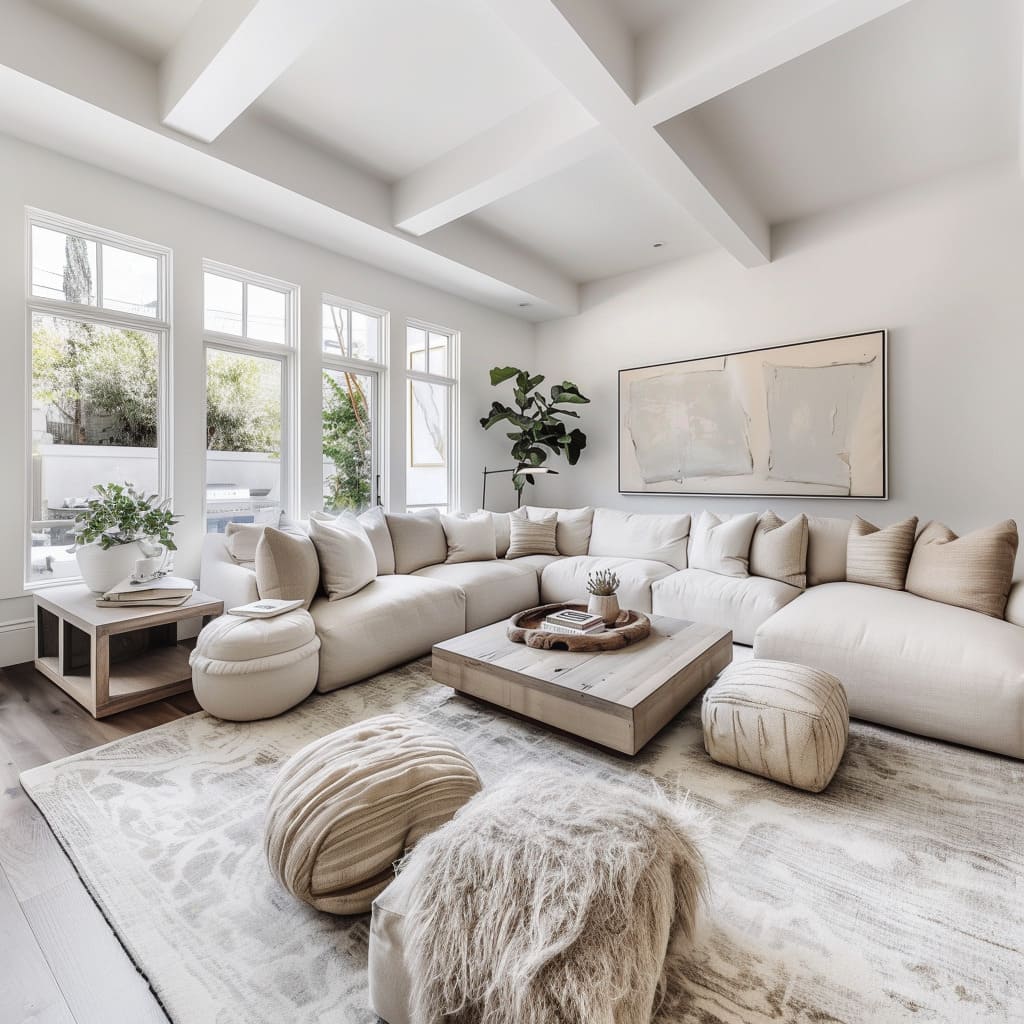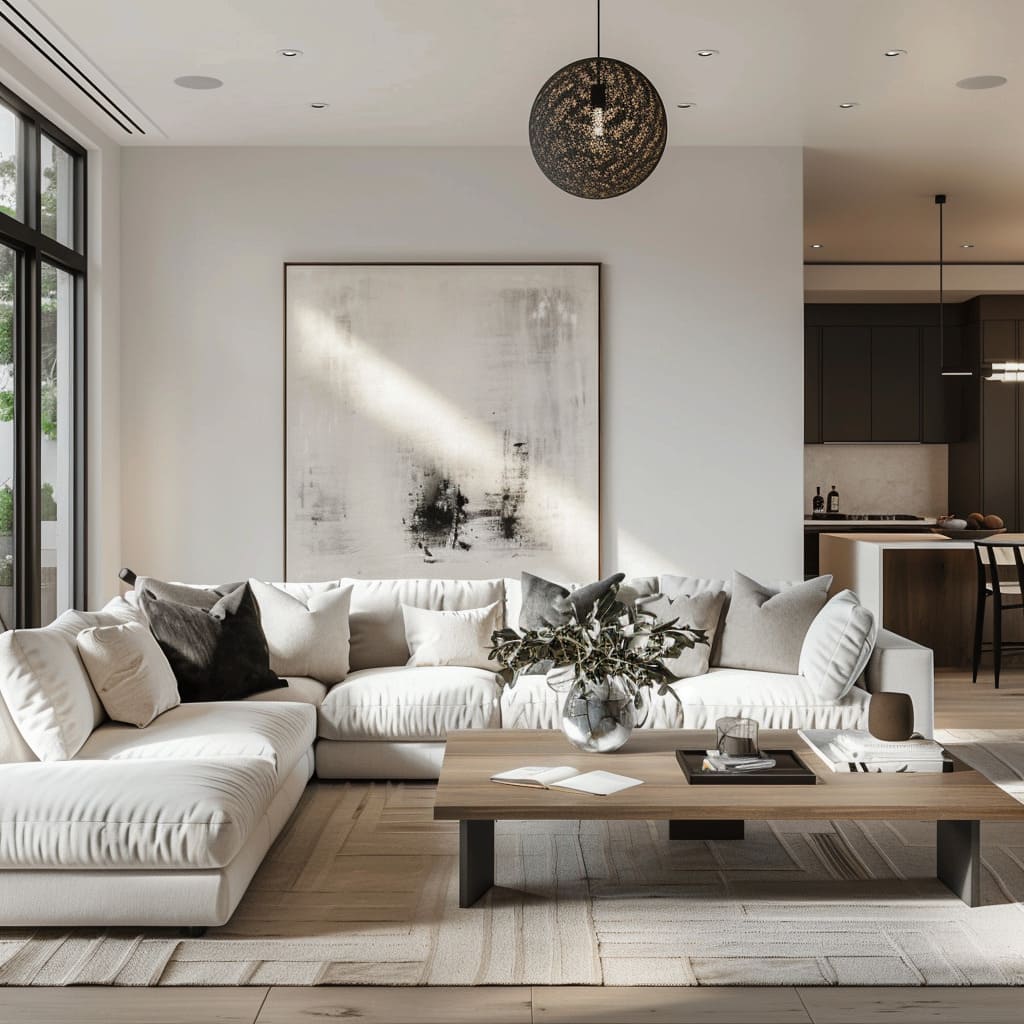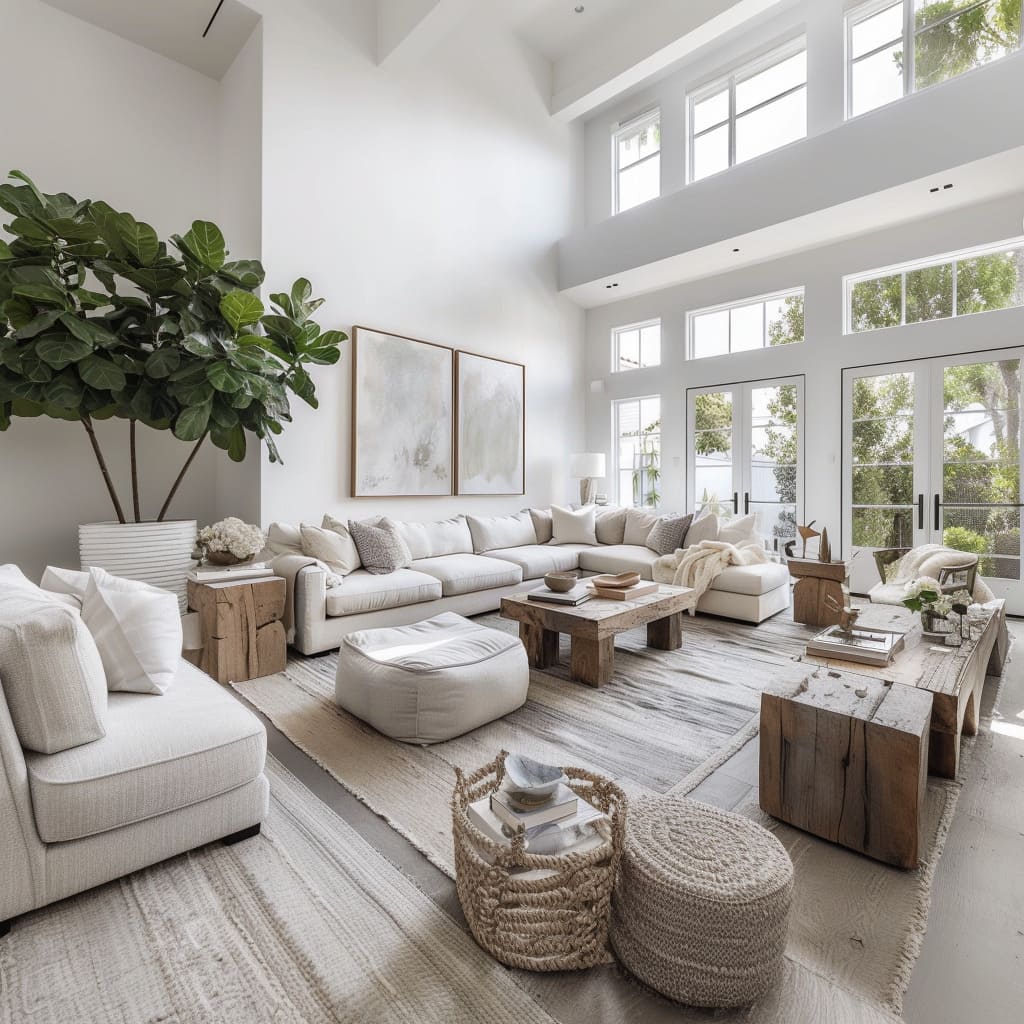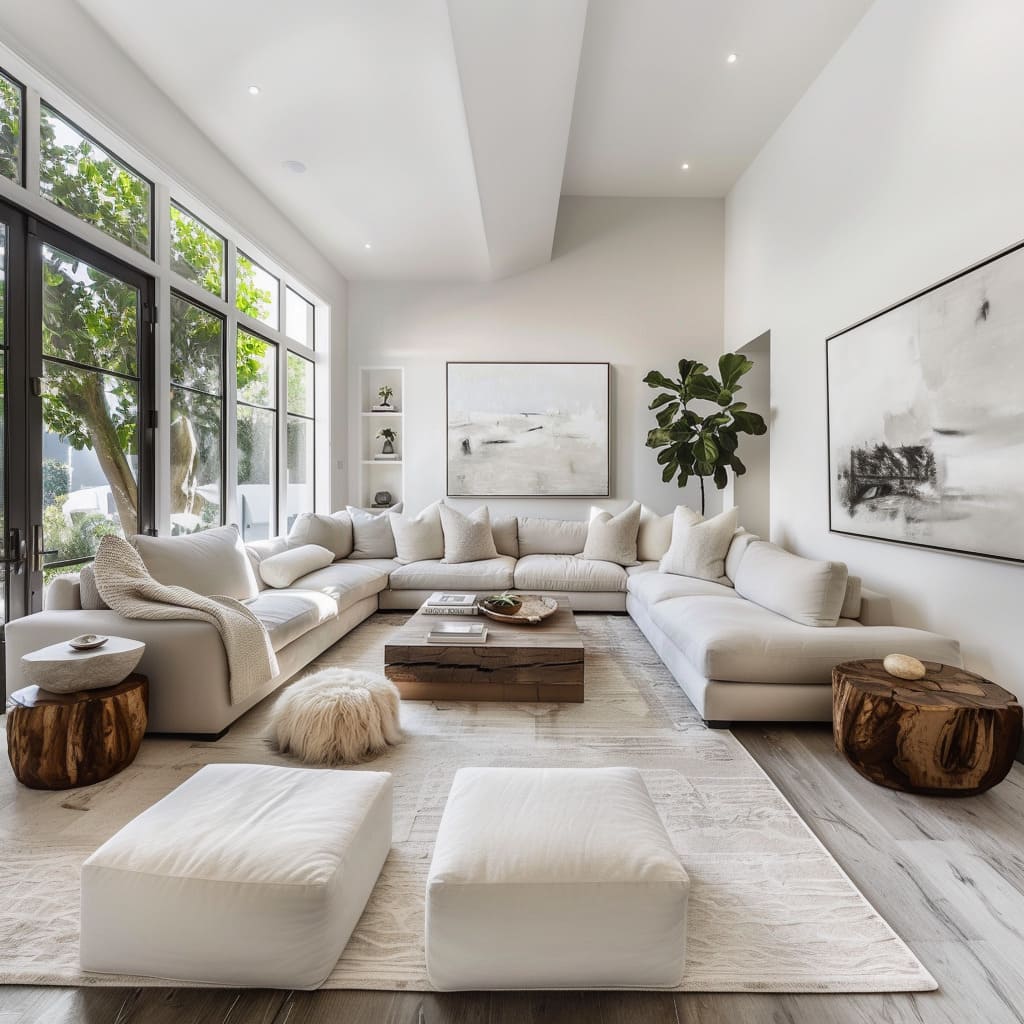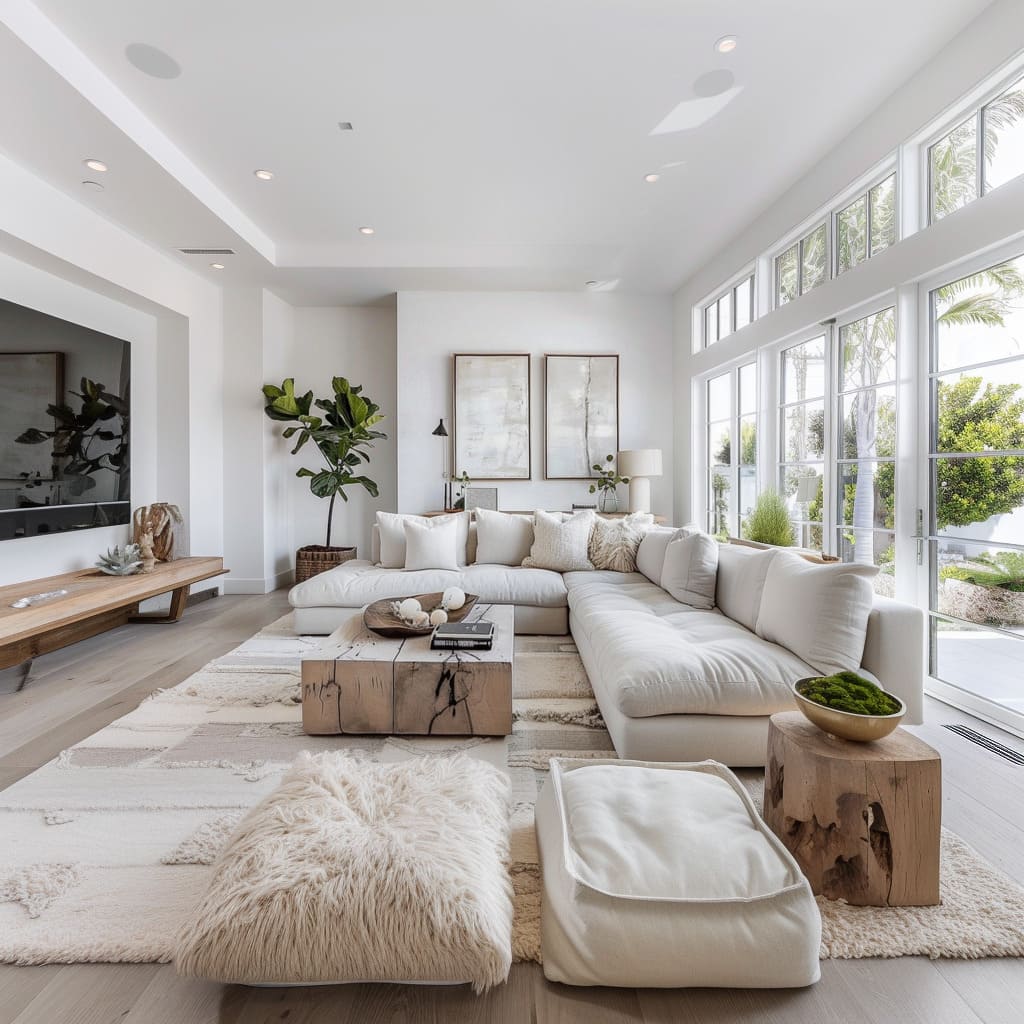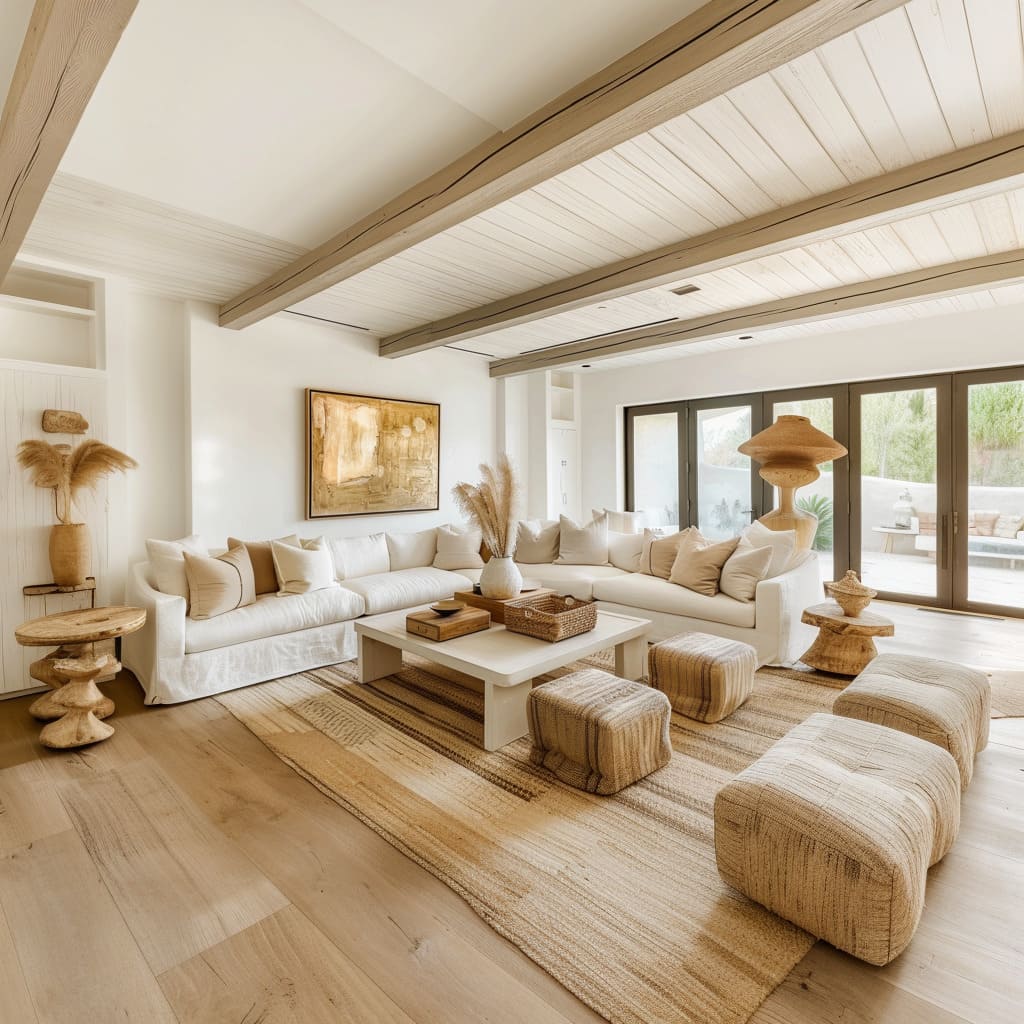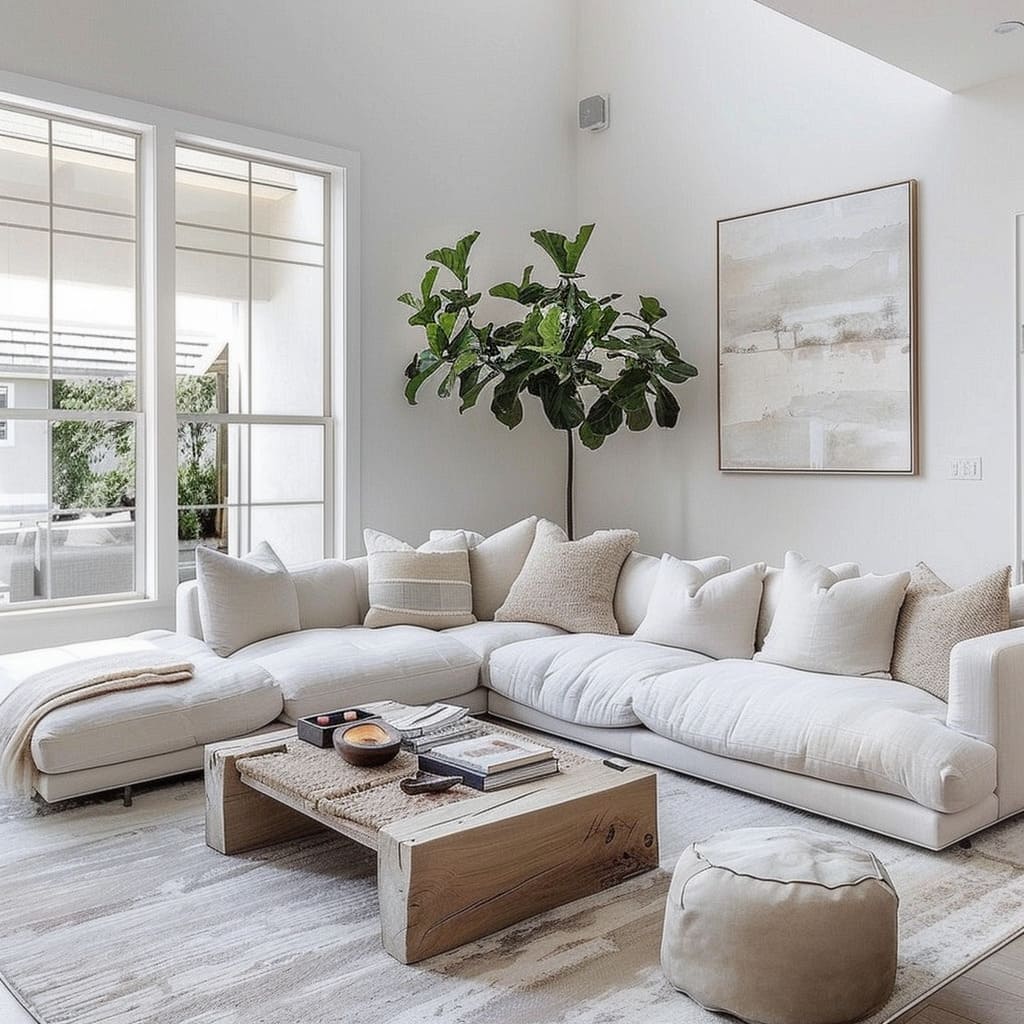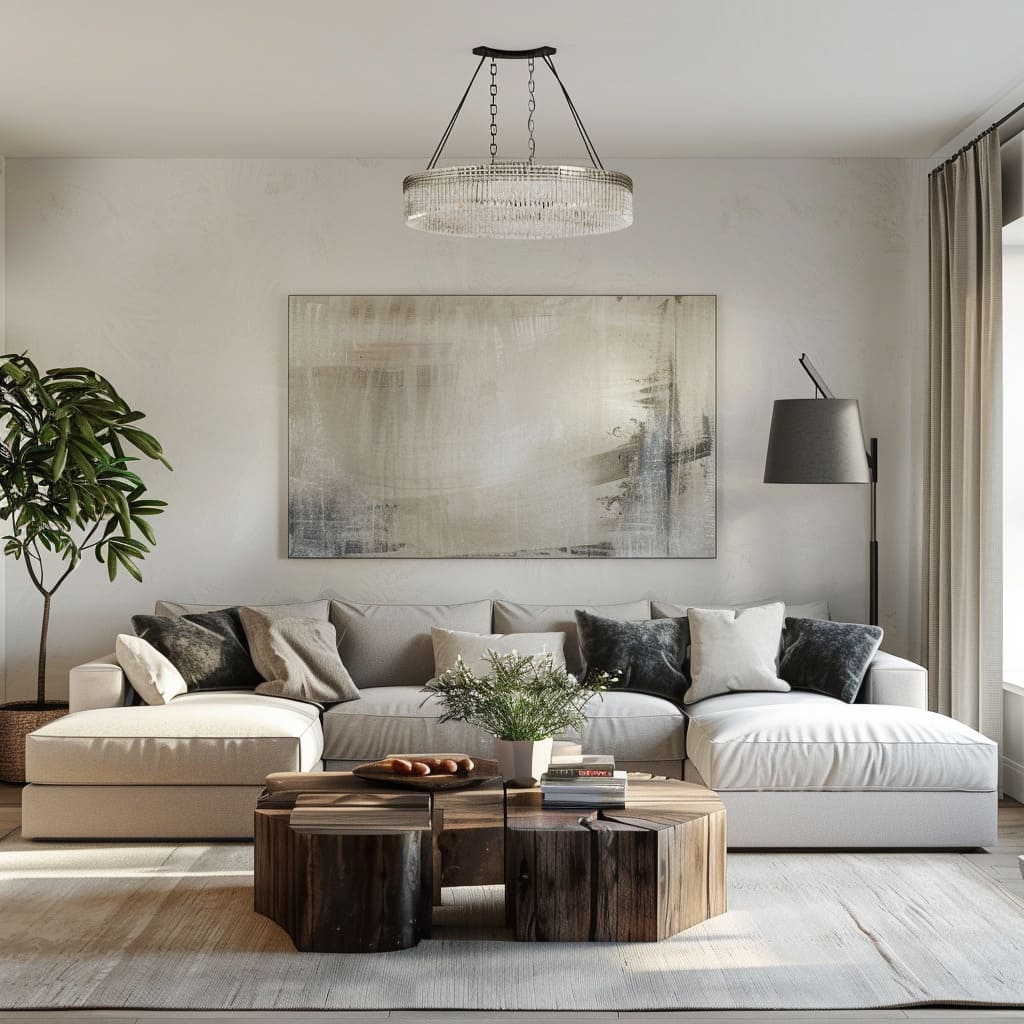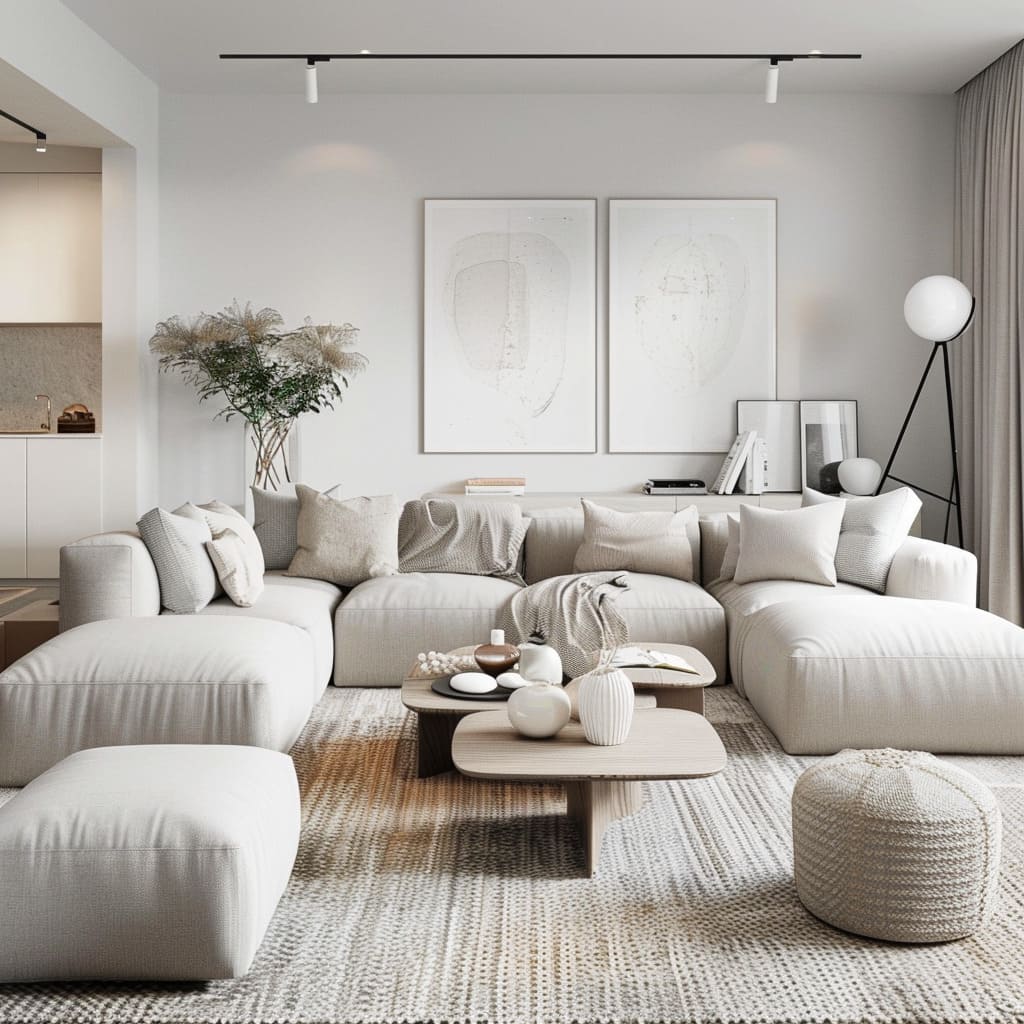In the intersection of function and form, the contemporary home stands as a testament to the thoughtful blend of technology, comfort, and aesthetic appeal. The traditional boundaries between utility and beauty blur as modern design philosophies redefine the concept of living spaces.
This exploration is not merely about the objects that fill our homes but about crafting environments that resonate with the rhythm of daily life and the subtle intricacies of human interaction with our surroundings.
Sensory and Spatial Harmony
A well-designed space considers the harmonious blend of sensory experiences and the strategic arrangement of elements within it, creating a fluid and intuitive environment that caters to both movement and emotion.
In the configuration of contemporary interiors, there is a conscious effort to shape the spatial flow, arranging furniture and decor in a manner that not only looks visually appealing but also guides movement through the space. Thoughtful positioning of couches, tables, and chairs directs the flow of traffic, creates zones of activity, and establishes clear, unobstructed pathways, allowing for an intuitive and stress-free navigation throughout the living area.
The acoustic environment within a home plays a crucial role in enhancing comfort. Design choices include plush rugs, soft throw pillows, and upholstered furniture, which contribute to absorbing sound, thus maintaining a serene and peaceful atmosphere.
The materials are selected not only for their aesthetic value but also for their ability to soften echoes and reduce noise pollution, ensuring that conversations can be held without the need to raise voices and that quiet moments remain undisturbed by harsh acoustics.
The sensory balance within a space is a testament to a well-rounded design philosophy. An environment that caters to the tactile senses with a variety of textures—smooth countertops, soft fabrics, and plush cushions—invites touch and comfort.
The auditory sense is considered with the soft hum of high-quality air systems and the almost imperceptible sound of state-of-the-art appliances. Even the olfactory sense is taken into account, with the subtle infusion of scents through carefully chosen diffusers or the natural aroma of indoor plants, enhancing the atmosphere without overwhelming the senses.
Soundscaping is a deliberate design strategy that involves the use of various materials and elements to influence the home’s acoustics. Wall fabrics, for instance, may be used not just for their visual appeal but also for their sound-dampening qualities.
They work alongside other features, such as bookshelves filled with literature and decorative items, to break up sound waves and reduce the travel of noise. Each element is chosen to contribute to a cohesive auditory experience, ensuring that the home’s soundscape supports both lively social gatherings and tranquil personal retreats.
Lighting and Atmosphere
The manipulation of light, both natural and artificial, is pivotal in modern interior design. It shapes the room’s mood, alters perceptions of space, and highlights the design’s architectural strengths.
The role of lighting in modern interiors transcends mere functionality—it sculpts the atmosphere, softly enfolding the living space in a warm embrace that enhances the overall mood. Strategically placed fixtures emit a gentle luminescence, ensuring a calm and inviting environment.
These fixtures are often recessed, or subtly integrated into the architecture to provide a consistent, even light that blankets the area without creating harsh shadows or overly bright spots.
Innovations in lighting technology allow for systems that can adjust to meet the dynamic needs of the inhabitants. With adaptive lighting, the brightness and even the hue can be modified—bright and energizing for the morning, or muted and warm for the evenings.
Such systems can often be controlled through smart devices, allowing for real-time adjustments that respond to the rhythms of daily life. The art of light craftsmanship goes beyond the mere selection of fixtures, involving a thoughtful process of considering how light plays within the space.
Designers select or commission pieces that are both functional and artistic, making lighting a central element of the interior design. These could range from bespoke pendant lights that act as focal points to subtle track lighting that highlights art or architectural details.
Indeed, lighting becomes an intrinsic element of the architecture, an aspect of design that can define spaces without the need for physical barriers. By carefully planning the placement and type of lighting, designers create layers of illumination that not only serve to reveal the beauty of the home but also to craft an ambience that resonates with those who dwell within.
Intelligent design ensures that light flows through spaces, giving life to textures and surfaces, and fostering an environment that is both practical for tasks and conducive to relaxation.
Natural Elements and Sustainability
Reflecting a growing awareness of environmental impact, contemporary interior design incorporates natural forms and materials, promoting sustainability without sacrificing sophistication or comfort.
Incorporating glass within an interior space introduces an element of transparency and lightness, inviting natural light to meander through the room. Glass surfaces, such as tabletops or decorative features, serve not only as functional aspects of the furniture but also enhance the visual spaciousness of the room.
Their reflective properties can amplify daylight, contributing to an environment that feels open and connected to the outside world.
The thoughtful integration of plant life into living spaces transcends mere decoration. Foliage and flowers are chosen not only for their visual beauty but also for their functional benefits, like air purification.
They contribute to a healthier living environment, bringing a touch of the outdoors inside and providing a visual rest that connects the inhabitants with the rhythms of nature. This greenery often includes a mix of large leafy plants that can improve air quality, along with smaller, fragrant varieties that can naturally perfume the room.
The influence of the natural world is evident in the choice of decor, where organic shapes abound. These pieces, with their curves and forms that echo the undulating lines found in nature, provide a contrast to the straight lines of modern architecture, adding an element of softness and spontaneity to the environment.
From rounded vases that mimic pebbles to art pieces that resemble the fluidity of water, these shapes promote a sense of calm and groundedness. Awareness of environmental impact is deeply embedded in the design choices, which extend to considerations of energy consumption and sustainable practices.
Energy-efficient lighting, appliances with low environmental footprints, and furniture made from recycled or responsibly sourced materials are common features. This commitment reflects a recognition of the importance of conserving resources for future generations and a respect for the natural world.
The exploration and application of innovative materials also mark these spaces. Designers and homeowners alike are drawn to materials that are not only new and visually stunning but also sustainable.
Bamboo, recycled composites, and even upcycled textiles find their way into the furniture and finishes, providing durability and style while also contributing to a more sustainable way of living. These materials often have stories of their own, from the renewable nature of bamboo to the transformative beauty of glass recycled from different sources, adding layers of meaning to the home’s design.
Artistry and Craftsmanship
The true essence of design lies in the details that showcase the artistry and craftsmanship. It’s about celebrating the hands that made them and the cultural stories they tell.
The selection and juxtaposition of textures within a space are a testament to the sophisticated understanding of materiality in design. Soft woven fabrics, smooth polished stone, and warm wooden elements are combined not just for visual appeal but to invite a tactile interaction.
This sensory engagement with varied materials adds depth and interest, encouraging one to pause and appreciate the finesse with which each texture complements the other, creating a harmonious sensory experience that is sophisticated yet understated.
Within these interiors, every piece of furniture and decor stands as a representation of the maker’s expertise. The intricate weave of a hand-knotted rug, the precise joints of a wooden table, or the delicate brushstrokes on a ceramic vase—all are testament to the hours of dedication and skill invested in their creation.
These pieces do not shout for attention; rather, they exude a quiet confidence, their quality evident in every detail. Subtle incorporations of cultural elements within the decor provide an intimate connection to personal heritage or global traditions.
These may manifest as a hand-painted scroll, a patterned throw, or a uniquely shaped sculpture, each bringing its own story and significance. They serve as a homage to diverse backgrounds and experiences, infusing the space with depth and personal meaning while respecting the overall aesthetic unity.
The presence of dynamic forms introduces an element of the unexpected, with sculptures and pieces of furniture that seem to be caught in motion. Curved backrests, spiraled accents, and undulating sculptures break the monotony of straight lines and right angles, adding a sense of liveliness and kinetic energy.
These forms provoke curiosity and interaction, serving as visual anchors that draw the eye and provoke conversation.
Tactile Experience and Fluidity
Modern interior design goes beyond visual aesthetics to include how a space feels. The interplay of textures and shapes encourages engagement and creates a fluid and dynamic living environment.
The use of rounded corners in furniture design not only visually softens the interior but also promotes a feeling of safety and comfort. These soft edges contribute to a welcoming atmosphere, drawing people in and inviting them to relax and stay awhile.
The gentle curves of a sofa or the rounded edge of a dining table add a human-centric approach to design, ensuring that interactions with the furniture are always pleasant and never jarring.
Surfaces within the space are designed with a tactile appeal in mind. Materials are not chosen solely for their durability or appearance but also for the sensations they elicit upon touch.
A velvet throw pillow, a knitted blanket, the grain of a wood finish, each with a distinct feel, encourages one to run their hands over surfaces, forging a deeper, more intimate connection with the environment. This sensory engagement brings a personal dimension to the space, making it truly one’s own.
In these living spaces, color is employed with thoughtful intention, enhancing the design without becoming the focal point. Strategic pops of color in throw pillows, artwork, or even a statement piece of furniture add vibrancy to rooms dominated by a soothing, neutral palette.
These touches of color enliven the environment and create a dynamic visual landscape, yet they do not compete with the calm serenity that the neutrals establish.
The overall fluidity in the space is a blend of all these elements, creating an environment that is not only a visual feast but also a tactile haven. Here, one can move seamlessly from one area to another, always in a state of physical and visual comfort, with colors that provide a subtle guide and textures that keep the senses engaged.
The space feels alive and interactive, yet simultaneously serene and cohesive, an embodiment of modern living where every detail is both beautiful and purposeful.
As the final brushstroke completes a masterpiece, so does the careful consideration of every design element culminate in a living space that transcends the ordinary. The fusion of tactile experiences, fluid forms, and conscious choices creates an abode that not only accommodates the functional demands of its inhabitants but also responds to their unspoken yearnings for tranquility, connection, and beauty.
It is here, in these thoughtfully curated environments, that the essence of modern living truly comes to life—a harmonious blend of innovation, tradition, and mindful design, setting the stage for a life well lived.
Seamless Integration and Comfort
This article section delves into how modern homes integrate advanced technology and comfort without compromising on style. Furnishings are no longer mere objects within a room; they are dynamic components that enhance lifestyle through seamless technology and ergonomic design.
In contemporary living spaces, the subtle fusion of high-tech amenities with the home’s aesthetic creates a seamless flow of design and function. Advanced appliances and home systems are integrated in such a way that they maintain the visual continuity of the space, without sacrificing the latest in convenience and efficiency.
In these rooms, one may find appliances that mirror the color and texture of the walls or countertops, creating a cohesive look.
Furniture isn’t just about style—it’s about living well. Many modern pieces are designed with the user’s well-being in mind, featuring adjustable components for head and back support.
Imagine couches and chairs that allow the user to fine-tune their seating experience, promoting a comfortable posture and providing support where it’s needed most.
Flexibility is at the heart of modern interior design, with modular components that invite rearrangement to suit changing needs. Such pieces can transform a space with ease, allowing for an array of configurations—from intimate gatherings to open space for solo relaxation.
Efficient use of space is a hallmark of smart design. Furniture with dual purposes, like sofas with built-in storage or coffee tables that expand into dining tables, exemplify clever use of space.
These transformative pieces work double duty, offering a place to rest or dine while also providing discreet storage solutions, making them perfect for smaller urban homes or for those who prefer a minimalist approach to their living areas.

